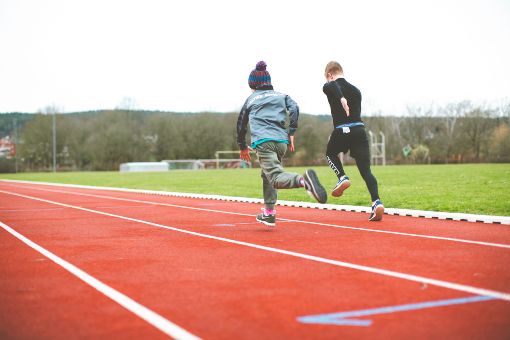
Athletics In Schools
Why Athletics In Schools Enhances School Ethos And Gives Children Critical Life Skills
Children experience athletics from a very young age. They unknowingly participate in athletic activities as soon as they can run or throw. It’s one of the sports that children participate in when they first attend school and is one of the most inclusive and prolific sports. Athletics events are all-season and allow athletes to compete alone or against other athletes. No matter what their skill level is.
For those that don’t know, athletics covers a range of sporting events and competition formats. All of which are underpinned by three main physical activities: running, jumping, and throwing. Some athletics events can be played indoors or outdoors, usually in sports halls, or sports MUGAs. While other athletic sports, like cross country, are exclusively outdoors.
As you read through this article, you’ll discover why athletics is a fundamental part of a child’s development and positive experience at school. And what types of athletics sports are common (or expected) throughout a child’s school experience.
How To Get Your Child Into Athletics
As a parent, you may be interested in encouraging your child to engage in athletics. It’s a wise choice and one that your child will no doubt thank you for in later life. The good news is that you won’t need to put too much effort into looking for the right athletic resources for your child. Most athletic resources are available at your child’s school.
All schools must meet the national curriculum standards for physical education, which naturally include athletics or the elements of athletic sports for younger children. Schools should develop competence to excel in a broad range of physical activities. Some of which include the key athletic activities: running, throwing, and jumping. It also encompasses a range of skills that support the development of a child’s athletic prowess throughout the key stages. Such as balance, agility and coordination, and of course, a competitive spirit and sportsmanship.
As your child progresses through their educational key stages, the level of athletic skill taught builds on those the child learns from the earlier stage.
If your child takes a particular interest in an athletic sport (or shows advanced skills) we suggest finding out what athletics after-school clubs are available at your child’s school. And if that still doesn’t satiate your child’s athletic needs, there are also plenty of athletics clubs in local communities (starting at junior level) that your child could attend in their free time. Some schools are also involved with private athletics clubs, like England Athletics, who run fun and engaging athletics programmes for schools. Though it’s important not to push your child too hard especially in their younger years — it could be detrimental to your child’s physical development. The schools and athletics clubs will usually offer the right level of athletic training appropriate for the child’s age group.
What Is The Important Role Of Athletics In Schools?
As a school, you probably already realise the value of teaching athletics. You know the importance of physical education for a child’s education and development, it’s a necessary topic because of the national curriculum. However, there are some, sometimes overlooked, important factors that the role of athletics in schools can bring to your school itself and your students.
Parental, Social and Peer Pressure To Provide Sound Athletic Facilities In Your School
 Many parents are beginning to recognise the importance of athletics for their child’s development and are actively seeking out schools that can provide the right kind of facilities they deem important. Research by the Youth Sport Trust shows how sporting facilities are the second most popular reason for choosing a secondary school. Second only to the wellbeing of pupils, and closely followed by the school’s culture and ethos. These two factors were more important to parents than Ofsted ratings, or exam results were. It is a similar story for primary school parents. While they did not seek out sporting facilities, they did seek out child wellbeing and the school’s culture and ethos.
Many parents are beginning to recognise the importance of athletics for their child’s development and are actively seeking out schools that can provide the right kind of facilities they deem important. Research by the Youth Sport Trust shows how sporting facilities are the second most popular reason for choosing a secondary school. Second only to the wellbeing of pupils, and closely followed by the school’s culture and ethos. These two factors were more important to parents than Ofsted ratings, or exam results were. It is a similar story for primary school parents. While they did not seek out sporting facilities, they did seek out child wellbeing and the school’s culture and ethos.
Parents are looking for sports facilities, science and tech labs, and clear demonstrations of how schools are protecting the well-being of their pupils. Some schools even take part in the Well Schools programme, a movement created by the Youth Sport Trust towards creating schools that are more focused on wellbeing. And, of course, sports like athletics are a key feature.
The UK government’s guidance on physical activity, and sports clubs like Aspire, work to change attitudes towards physical education. They educate parents and children about physical education. And all play their roles in turning parents’ attention to the importance of quality sports facilities (like athletics facilities) in the school their child attends.
Fortunately, athletics, wellbeing and a positive school ethos all go hand-in-hand. Usually by creating healthy children and a good dose of school comradery. All of which leads to school recognition. Exactly what your school needs to help aware parents feel confident that your school is the best option for their child.
School Comradery
Sports like athletics are cornerstones in building a positive school environment. They create a sense of pride, discipline and comradery amongst students. The events associated with athletics, like competitions and pre-game celebrations, are key factors in bringing a school together to support a student, or team, as they compete in their sporting events. And it’s this comradery, and collective pride, that helps to create an appealing school culture for the students, staff, and parents. Furthermore, students learn many life lessons from these experiences which include bond building, overcoming personal differences and the importance of togetherness.
School Recognition
Schools don’t often find it easy to gain attention from the local media, or indeed their community. Successful and engaged athletics teams within your school will surely be the megaphone you need to convey how your school is meeting the demands for a positive and encouraging school ethos. This coverage may even encourage parents to want to send their children to your school. You may also find a way to seek out sponsorship for having an excellent athletics team. Something that can contribute to better equipment for your school and further compound the positive environment you’re creating.
What Skills Do Athletics Teach Children?
A sound school ethos isn’t the only advantage that athletics brings to your school. Taking part in athletic sports also teaches your students some valuable life lessons in addition to those they’d gain (mentioned above) from supporting your school’s athletics team.
Critical Life Skills
There is a wide range of critical life skills that children develop as they participate in athletics, here are a few examples:
- Resilience – Athletics teaches students that even when they fail or don’t accomplish their goals, that they can keep on trying. That determination, focus, and practice make perfect. And that with enough effort you can accomplish your goals.
- Commitment – In an ever-changing world where we can do almost whatever we want at the touch of a button, commitment is becoming a scarce critical life skill. Athletes will develop a strong sense of commitment — they can’t succeed without it.
- Self-discipline – An athlete needs to carry out the tasks and requirements that their coaches or teachers assign to them so that they can succeed. This takes a lot of self-discipline, time management and sacrifice. But a student who accomplishes this skill will enjoy both athletics and life success.
- Teamwork – Most athletes are working toward two goals, their personal goals and their athletics team goals. Learning how to contribute positively to a team while also working alone is a critical life skill that will help any student live a happy and successful future.
What Types Of Athletic Sports Do UK Schools Teach?
Running, throwing and jumping form the basis of all athletics sports. Typical examples of athletic sports that students will commonly experience during their school years involve:
Field Events
Running is the key denominator for field events, except for hurdles, which also involves jumping. You might experience:
- 100-Metre Sprint: Participants run 100 metres and time their performance. Then they develop the skill to beat their personal best. The 100-metre sprint can also form a race where participants will race against each other rather than against the clock.
- 400-Metre Sprint: The 400-metre sprint is the same as the 100 metres, but it’s more advanced since it’s longer and requires careful pacing.
 Relay Racing: A team of participants races against another team by running a circuit while passing a baton to each player. The team takes position around the circuit ready to take hold of the baton when it’s passed to them. When the player has the baton, they must run as fast as they can to the next player and hand over the baton. The team that completes the race first wins. It’s also possible to play against the clock rather than against other teams.
Relay Racing: A team of participants races against another team by running a circuit while passing a baton to each player. The team takes position around the circuit ready to take hold of the baton when it’s passed to them. When the player has the baton, they must run as fast as they can to the next player and hand over the baton. The team that completes the race first wins. It’s also possible to play against the clock rather than against other teams.- Hurdling: Hurdles are obstacles that are situated along the running track. They are usually horizontal posts held up by two vertical posts (called hurdles). The participant has to run as fast as they can along the track, clearing the hurdles as they go. You can race against others with this athletic sport or time yourself and attempt to beat your personal best.
- Cross Country Running: Runners run in the open air, far away from the standard athletics tracks in their schools and clubs. They run over natural terrain, usually in a race but they can run against the clock. The natural terrain, such as grass, mud, and rocks adds to the challenge and enjoyment of this athletic discipline.
Track Events
If you participate in a track event, it’ll involve throwing or jumping and while running isn’t the star of the show, you usually need to do a small amount of running to build up speed for the throw or jump. Typical track events include:
- Pole Vault: Athletes run and jump using a pole to vault themselves over a horizontal bar (a crossbar) without touching it, or knocking it out of its position. Olympic pole vaulters jump at heights of around 16 to 20 feet (6.1 metres). But at school level, the bar will be much lower and is usually raised in incremental measures of 10 cm.
 High Jump: Athletes run and jump unaided over a horizontal bar without touching it, or knocking it out of its position. The bar’s height usually ranges between one and four feet high.
High Jump: Athletes run and jump unaided over a horizontal bar without touching it, or knocking it out of its position. The bar’s height usually ranges between one and four feet high.- Long Jump: The long jump is a common athletic sport in many junior and senior schools where participants run and jump as far as they can unaided into a sandpit. The landing spot measurements are taken so that the athlete can compete against their personal best or other athletes.
- Triple Jump: Athletes run and then take a hop, step and jump from a board before landing in a sandpit. The aim is to achieve the farthest distance from the board possible.
- Javelin: A javelin is a lightweight metal spear that is thrown by the athlete. The athlete runs to the throw line and attempts to throw their javelin as far as possible
- Shot Put: Similar to javelin but this field event features heavy balls instead of the javelin. The athlete throws the shot put as far as they can.
- Discus: This is another throwing event, but instead of throwing a ball or spear, the athlete throws a heavy disc (called a discus). The object is the same as javelin and shot-put — to throw the disc as far as possible.
What Types Of Athletics Do Infants Participate In At School?
Athletics begins for pupils at key stage 1, where they begin to learn the fundamentals of movement, they learn a range of disciplines to help develop balance, agility and coordination. They also learn how to engage, coordinate and compete in physical activity against themselves and as part of a team.
At this stage the kinds of activities involved will form the basis of athletics; running, jumping and throwing and catching, they also learn simple movement patterns. Infant schools won’t necessarily provide a running track — or other facilities required for athletics, they don’t need them. Instead, they’ll teach simple and fun athletic games suited to the child’s age. This approach helps children enjoy and become familiar with athletic activities.
What Does Junior Athletics In Schools Involve?
Key stage two students learn activities that build on their experiences in KS1, this is where they acquire their first taste of what it means to be an athlete. By taking part in activities that involve running, throwing and jumping individually, like running 100 metres, or learning how to hurdle. To meet the requirements of the National Curriculum students also engage in activities that combine these three elements of athletics into one activity.
Most schools or communities also have after school clubs, athletics clubs and junior athletics competitions to help KS2 students engage with the sport of athletics further. Some schools enlist the support of athletics clubs to enhance their athletics programme and encourage children to try other types of athletics like cross-country running. At KS2, athletics are required to help students learn strength, technique, control, balance and flexibility.
Secondary School Athletics: How Do Schools Engage Their Students?
Students at KS3 level will usually have access to the full range of athletic track and field sports. At this level, they’ll experiment with each sport to determine what they enjoy and they’ll compound their experiences learned in KS1 and KS2. They’ll also develop full competency and skill in a variety of athletics events. It’s also at this stage where some students will find a passion for athletics and will begin to compete more seriously. Some might take their passion further by training out of school too.
No matter who you are, if you attend a UK school you will experience athletics in some form because the fundamental athletic skills form the basis for almost every other sport and are also useful in real life. Furthermore, the non-sports related skills a child learns as they participate in athletics has a positive and profound impact on a child’s life now, and into adulthood.
Athletics also promotes a positive and appealing school culture, enabling you to attract good staff, pupils, opportunities and even funds to your school. If you want to learn more about how you can increase your athletics activities, these top schools for athletics will be the inspiration you need.
 Relay Racing: A team of participants races against another team by running a circuit while passing a baton to each player. The team takes position around the circuit ready to take hold of the baton when it’s passed to them. When the player has the baton, they must run as fast as they can to the next player and hand over the baton. The team that completes the race first wins. It’s also possible to play against the clock rather than against other teams.
Relay Racing: A team of participants races against another team by running a circuit while passing a baton to each player. The team takes position around the circuit ready to take hold of the baton when it’s passed to them. When the player has the baton, they must run as fast as they can to the next player and hand over the baton. The team that completes the race first wins. It’s also possible to play against the clock rather than against other teams. High Jump: Athletes run and jump unaided over a horizontal bar without touching it, or knocking it out of its position. The bar’s height usually ranges between one and four feet high.
High Jump: Athletes run and jump unaided over a horizontal bar without touching it, or knocking it out of its position. The bar’s height usually ranges between one and four feet high.